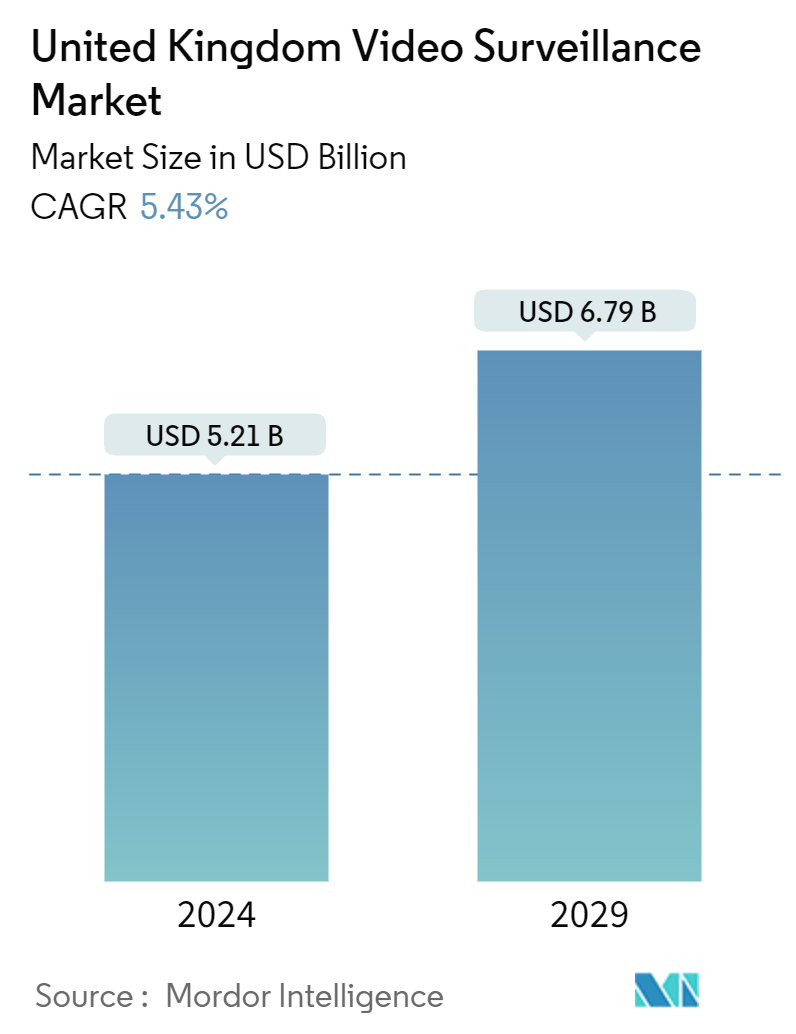Market Size of United Kingdom Video Surveillance Industry

| Study Period | 2019 - 2029 |
| Base Year For Estimation | 2023 |
| Market Size (2024) | USD 5.21 Billion |
| Market Size (2029) | USD 6.79 Billion |
| CAGR (2024 - 2029) | 5.43 % |
| Market Concentration | Low |
Major Players
*Disclaimer: Major Players sorted in no particular order |
United Kingdom Video Surveillance Market Analysis
The United Kingdom Video Surveillance Market size is estimated at USD 5.21 billion in 2024, and is expected to reach USD 6.79 billion by 2029, growing at a CAGR of 5.43% during the forecast period (2024-2029).
The industry is pursuing digital and networked systems and developing higher-resolution cameras and standard communication protocols between the products. The video surveillance industry is on the verge of transforming into an AI-driven security system. A full range of AI security solutions are emerging from the existing video surveillance systems. These systems will record video footage but do much more to improve security and safety. This shift is due to customers' decreasing interest in video and their increased concern for preventing and resolving safety issues.
According to the British Security Industry Association (BSIA), the total number of security cameras in the United Kingdom is around 5.2 million, or around one security camera for every 13 people in the United Kingdom. The number of cameras has remained consistent, with an increase in the same pattern as population growth. Despite this, only one crime per 1000 cameras is resolved due to poor-quality images supplied by most camera installations. The demand for technical improvements in all aspects of the systems is therefore driving the market growth.
In the United Kingdom, there is a significant change in how surveillance cameras are being used and regulated, with AI-based biometric technology rapidly becoming a preferred method of identification by law enforcement agencies and the growing use of live facial recognition. There is estimated to be at least one camera for every 13 people in the country, with more than 95% of these cameras operating exclusively, and there is an increasing number of them. The College of Police says surveillance could prevent as many as 16 to 51 crimes in 100.
Moreover, the government is trying to solidify the regulations regarding installing surveillance systems in public places. The UK government is introducing a Criminal Justice Act to enable police and national crime agencies to check facial recognition on UK driver's license databases. In 2023, the government also announced the abolition of the office of the Biometrics and Surveillance Camera Commissioner (BSCC), an independent watchdog, from 2024 as part of its Data Protection and Digital Information Bill (DPDI Bill).
In June 2023, the government announced its plans to remove Chinese-made surveillance equipment from sensitive installations to address concerns that it could be used for spying by China, tightened procurement rules, and ordered departments not to install Chinese surveillance cameras in sensitive establishments. These types of initiatives would encourage the in-house development of surveillance hardware and software products to acknowledge the demand.
Furthermore, the UK government is implementing increased border security. Critical national infrastructure sites such as power plants, government facilities, pipelines, and transport hubs are becoming increasingly important for protection. Spending on security is driven by continued urbanization, the expansion of public transport networks, and high-profile security breaches. Demand for qualified labor and more sophisticated security systems can only be stimulated by such a combination of technical innovation and the integration of systems.

